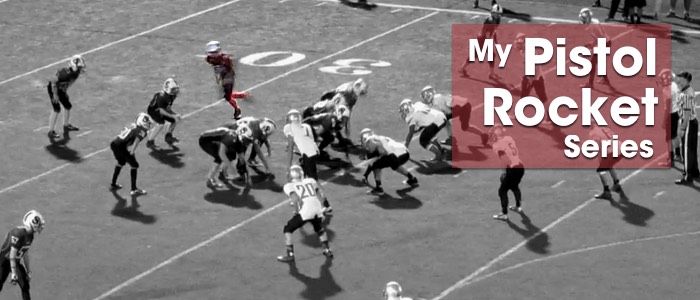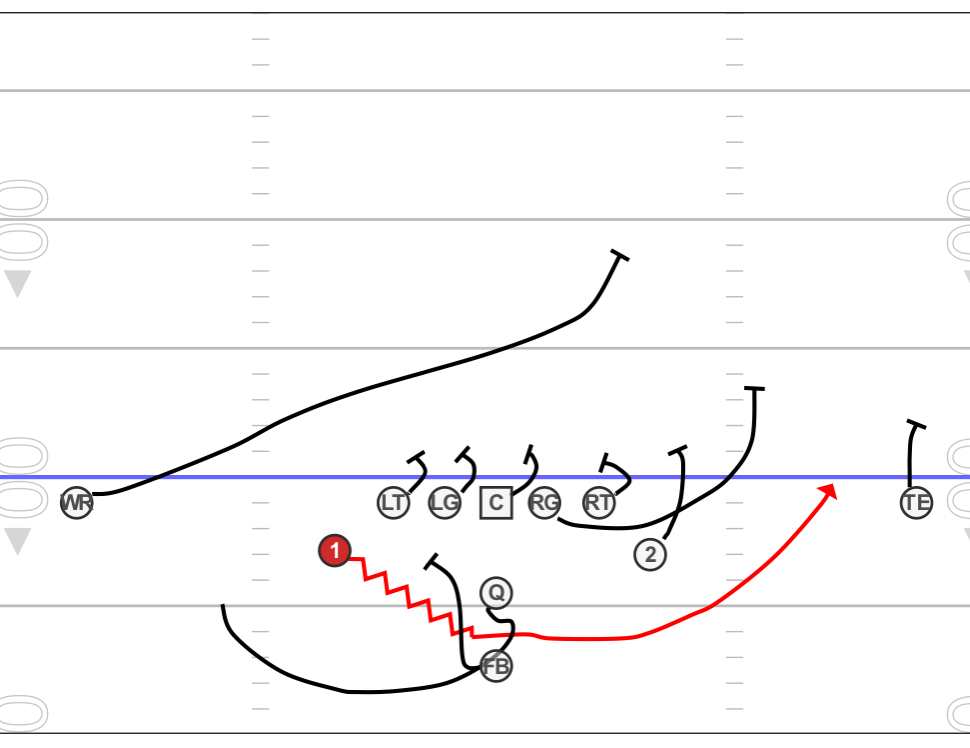My Pistol Rocket Series

Update on June 8, 2016 – Want to learn how to install and run the Pistol Wing-T? Pistol Wing-T for Youth Football. I go deep into the Rocket series in this book.
A coach asked me last month:
I am a devoted Wing-T guy and would love to learn as much as I can about the Rocket sweep and it's complementary plays.
Rocket Sweep and its complements haven't been a core part of my Wing-T installation for a while, same with local power house Sherwood High. Before last season I did a lot of study on Wing-T extensions and hybrid looks and was particularly inspired by a long face to face chat I had with former Carnegie Mellon offensive coordinator Rich Erdelyi. My older son Jacob is a student athlete at CMU, though he opted to throw javelin rather than continue his football career. I took advantage of some spare time when I dropped him off at the start of his freshman year in fall 2013 to bend Rich's ear (actually I wanted him to bend my ear) and he was kind enough to chalk talk for nearly 90 minutes and share a number of his clinic DVDs.
The series that caught my eye was his Pistol Series, which has Rocket Sweep as a core element. My co-coaches and I agreed to try to get some of this installed if we had the luxury, and the 2014 season was our first attempt.
First a side note on how and why we decided to add this in last season. Two key reasons:
- We weren't really sure going into the season how competitive we would be. We believed that a new wrinkle like this could give us a key advantage and break the mold if timed properly.
- We would use this as a mid-season engagement and rejuvenation strategy. Around game 4 or 5 we are always looking for something new to throw at the kids, be it a trick play, a new kick return, or in this case an entirely new formation and series.
I'm not going to write out the entire series in a blog post here, but perhaps I'll do an add-on playbook with video if there is interest. I'll cover the foundation of the series though.
Formation Approach
We introduced two new formations:
- Pistol Spread – We split out the TE into a WR/SE position, put both WB into wing positions outside the tackles, QB at about 3 yards depth (short shotgun), and the fullback 1.5 to 2 yards behind the QB. So this is a completely balanced look. We called this “Gun”.
- Pistol Closed – Same as the spread but we bring the TE back in. We would call this “Gun Rose” or “Gun Lily” depending on the TE position.
It didn't take long to install the C/QB snap. I'm not sure we ever had a bad snap in the 2 or 3 games we ran pistol.
Core Pistol Plays
Gun Rocket Sweep


The backside WB goes in full speed rocket motion on QB signal. He aims for a spot about 1 foot in front of the fullback, then flattens out. Is goal is to catch the ball in the C gap or wider. I won't cover every blocking assignment here but will call out a few key ones:
- The SE will crack down on first defender he sees inside the cornerback. We changed this up after initially having him stalk or run out the corner. The force player (usually a wide DE or outside linebacker) is often one of the best defenders on the field and we wanted to make sure we could take him out.
- The playside WB will block first man outside of C gap.
- The playside guard will pull wide and log first player outside the playside WB block.
- The playside tackle will step to playside like he is reaching but will only block a defensive lineman if he crosses his face while reaching. Otherwise he will get downfield and log, probably an inside LB.
The key teaching point we had to work on was the QB to FB pitch timing. This is something you can work on repeatedly in small group practice time. You can have the QBs play the snapper as that is a key part of the timing. I covered some of this in my National Wing-T Clinic notes.
Gun Rocket Counter

This turned out to be our money play. With full flow rocket motion, we fake the pitch and give the ball to the other WB who follows the back-side tackle who is pulling. The rest of the line blocks down away from the play.
The FB has the key block here and will kick out the first man he sees outside the frontside tackle down block, usually the defensive end. The backside tackle as I mentioned is pulling and will lead block through the hole. The wingback ball carrier takes a drop step with his inside foot, aims for the QB toes, and takes the inside handoff. He turns downfield quickly to follow the tackle.
Other Running Plays
Much of the Wing-T playbook is open from these formations, but a few work better than others. Here's what we ran:
- Rocket Trap – same blocking rules as the Buck Trap, but with Rocket motion.
- ISO – maybe the best inside run play out of the spread formation. Because the handoff is supposed to be deep with room for the FB to find the hole,the pistol look works well here.
Pass Plays
One advantage of running the pistol is your QB is in great position for a normal 3 step drop passing game. We ran a series of quick and slow screens out of this, plus some simple mirrored routes with the split ends and wing backs. We generally kept the FB home for protection, though the slow screen was a dump to the FB after faking protection. I'll share more on the passing game in a future post.